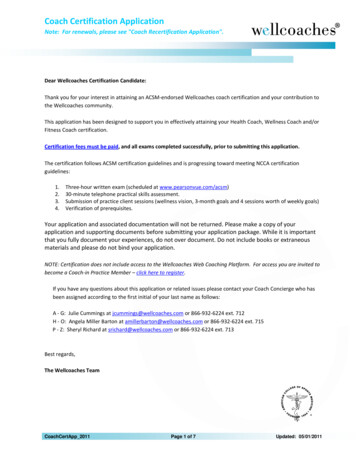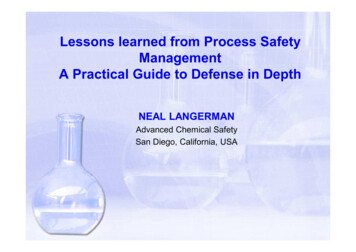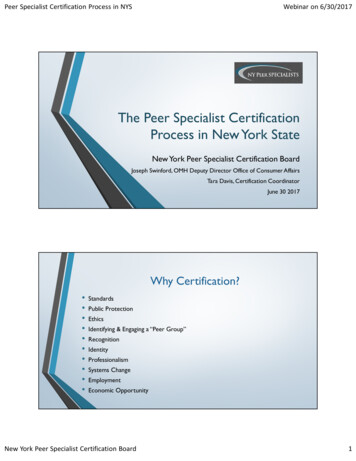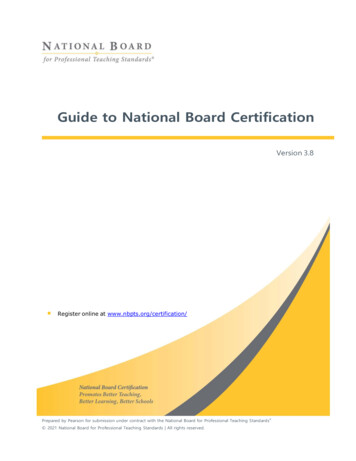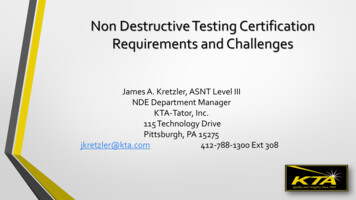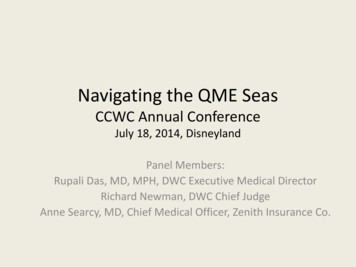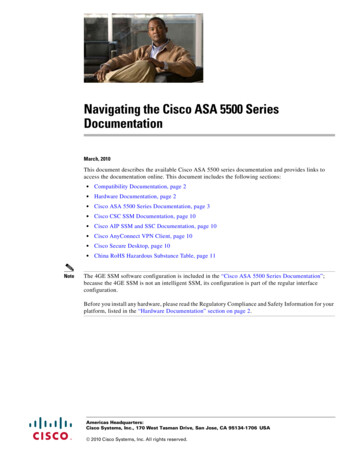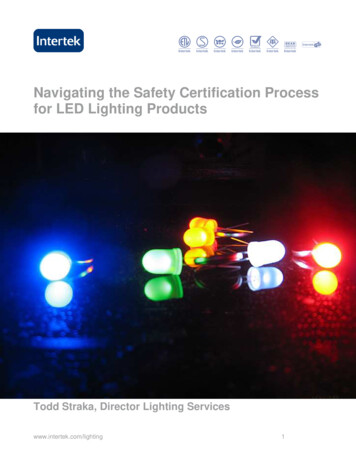
Transcription
Navigating the Safety Certification Processfor LED Lighting ProductsTodd Straka, Director Lighting Serviceswww.intertek.com/lighting1
Identifying Product Safety Requirements for Your Target MarketsAs solid-state lighting technology continues to rapidly evolve, the acceptance ofLED Lighting Products into global markets will continue to increase, presentingmanufacturers with significant business opportunities. Before any businessopportunity can be realized however, it is imperative that manufacturers firstconduct due diligence to identify applicable product safety certificationrequirements pertaining to their specific targeted global markets.For example, in the United States, according to the requirements of theOccupational Safety & Health Administration (OSHA), electronic equipment isdeemed to be safe for use in the workplace if it is listed by a NationallyRecognized Testing Laboratory (commonly referred to as a NRTL). NRTLs arequalified, 3rd party organizations that meet the requirements mandated byOSHA under 29 CFR section 1910.7 to perform independent safety testing andproduct certification.Basic Steps to Product Safety CertificationThe Product Safety Certification process can be brokendown into a few steps. First, a review of the product’sconstruction and design is performed, which includes carefulevaluation of specific product information, including the billof materials, applicable ratings of the individual componentsand materials, product design drawings and spacing anddimensional requirements. From the review of all submittedinformation, it is then possible to determine the appropriatetesting that will be required to sufficiently satisfy therequirements stated in the applicable standard(s).Steps to Certification:1.Review of productsconstruction & design2.Product testing phase(test to applicablestandards)3.Creation & issuance ofTest Report &Authorization to Mark(ATM)4.Participate in NRTL’sfollow-up servicesNext is the actual product testing phase, which is performedin accordance with the requirements of the applicable standard(s). Such testsmay include temperature, electrical, dielectric, strain relief, environmental (wetlocation), and mechanical tests, among others. Once the product hassuccessfully completed all Construction Review and Testing requirements, stepthree includes the creation and issuance of the formal Test Report &www.intertek.com/lighting2
Authorization to Mark (ATM), which grants the manufacturer permission to labelthe product with the applicable safety mark from the contracted NRTL (such asthe ETL Listed mark from Intertek).As a final step, the manufacturer must agree to participate in the NRTL’s followup services program. This typically involves an initial audit of the manufacturingfacility, as well as ongoing manufacturing facility inspections on a predetermined frequency (quarterly or monthly), to ensure consistent design,production, and labeling of the product. It is also necessary to maintain andupdate files to remain current with the latest revision of the applicablestandards.North American Product Safety Standards for Solid-StateLightingIn North America, product safety standards are published by organizations suchas the American National Standards Institute (ANSI), the National FireProtection Association (NFPA), Underwriters Laboratories (UL) and CanadianStandards Association (CSA) respectively, after gaining industry-wideconsensus. NTRLs (such as Intertek, UL, CSA) are authorized to evaluate andcertify products according to these standards. Each NTRL issues its own safetycertification mark, and each such mark is an equally valid indication ofcompliance with the standard(s).Existing lighting safety standards still apply for LED lighting, but evaluations arenow conducted incorporating UL 8750 Safety Standard for LED Lighting. Therequirements found in UL 8750 are intended to supplement those found in theexisting standards that relate to lighting (see Table).UL 8750 is a newly published standard, which covers LED equipment that is anintegral part of a luminaire, including LED drivers, controllers, arrays, modulesand packages. The first edition of UL 8750 was released in May 2009, and arevised version was published in September. After a further comment period,the final standard is expected to be published in before the end of 2009.www.intertek.com/lighting3
Other lighting standards are in the process of being updated to accommodateLED products. For example, UL 1993 covers Self-Ballasted Lamps and LampAdapters, and now includes a provision for replacement LED lamps. The thirdedition, published in August 2009, added requirements covering LED drivercircuitry, and also added requirements and limits for LED light sources. UL 1993is now also harmonized with ANCE (Mexico) and CSA (Canada). The mostcommon lighting standards for North America include:StandardFixed LuminairesUL 1598CSA C22.2 # 250UL 1573CSA C22.2 # 166UL 1574CSA C22.2 # 9Portable LuminairesUL 153CSA C22.2 # 12UL 1993CSA C22.2 # 250CSA TIL # B-64Specialty LuminairesUL 48CSA C22.2 # 207UL 676CSA C22.2 # 89UL 844CSA C22.2 # 137UL 924CSA C22.2 # 250CSA C22.2 #107.1UL 1786CSA C22.2 # 12UL 1838CSA TIL # B-58AUL 1994UL 2108UL 2388CSA C22.2 # 250Power SuppliesUL 1012CSA C22.2 # 107.1UL 1310CSA C22.2 # 223www.intertek.com/lightingProduct TypeLuminairesStage & Studio LightingTrack LightingPortable Electric LampsSelf-Ballasted Lamps and Lamp AdaptersElectric SignsUnderwater Lighting FixturesFixtures for Use in Hazardous (Classified)LocationsEmergency Lighting and Power EquipmentNightlightsLow Voltage Landscape Lighting SystemsLow-level Path Marking and Lighting SystemsLow Voltage Lighting SystemsFlexible Lighting ProductsPower Units Other Than Class 2Class 2 Power Units4
European Product Safety Standards for Solid-State LightingIn Europe, solid-state lighting products must conform with the applicableEuropean Directives and CE Marking guidelines. To achieve compliance for CEMarking, manufacturers must first construct a Technical File which includes allof the supporting documentation that verifies that the product meets theapplicable European Directives. Then the manufacturer issues a Declaration ofConformity, stating that their products fulfill all requirements.For solid-state lighting products, the two main Directives utilized in CEEvaluations include the Low Voltage Directive (73/23/EEC) and the EMCDirective (89/336/EEC). The most common lighting standards utilized in Europeinclude:SafetyEN 60598-1EN 60598-2EN 61347-1EN 60570EN 61347-1EN 61347-2-13EN 62031EMCEN 55015EN 61547EN 61000-3-2/3Luminaire General Requirements and TestsLuminaire Part 2 Requirements*Lamp Control GearElectrical Track Systems for LuminairesLED Power SupplyLED Power SupplyLED ModuleEMC EmissionEMC ImmunityHarmonicsLuminaire Part II RequirementsEN 60598-2-1Fixed luminairesEN 60598-2-2Recessed luminariesEN 60598-2-3Road and street lightingEN 60598-2-4Portable luminariesEN 60598-2-5FloodlightsEN 60598-2-6Luminaires with built-in transformers orconvertors for filament lampsEN 60598-2-7Portable luminaires for garden useEN 60598-2-8HandlampsEN 60598-2-9Photo and film luminaires (non-professional)EN 60598-2-10Portable luminaires for childrenEN 60598-2-11Aquarium luminairesEN 60598-2-12Mains socket-outlet mounted nightlightsEN 60598-2-13Ground recessed luminaireswww.intertek.com/lighting5
Luminaire Part II Requirements (continued)EN 60598-2-14Luminaires for neon tubes (under preparation)EN 60598-2-17Luminaires for stage lighting, television, filmand photographic studios (outdoor and indoor)EN 60598-2-18Luminaires for swimming pools and similarapplicationsEN 60598-2-19Air-handling luminaires (safety requirements)EN 60598-2-20Lighting chainsEN 60598-2-22Luminaires for emergency lightingEN 60598-2-23Extra low voltage lighting systems for filamentlampsEN 60598-2-24Luminaires with limited surface temperaturesEN 60598-2-25Luminaires for use in clinical areas ofhospitals and health care buildingsPhotobiological Testing Required for EuropeIn terms of biological hazards, exposure to ultraviolet wavelengths (100–400nm) is a concern. Additionally in Europe, LEDs are classified as Lasers and aresubject to meet specific test requirements. A new standard, IEC/EN 62471replaces the previous EN 60825-1, and includes specific performancerequirements and thresholds for Photobiological Safety of Lamps & LampSystems.The US and Canada currently do not have mandatory standards or regulationsin this respect. However, organizations such as IESNA, ANSI, CIE and IEC areactively evaluating these effects for future consideration.Efficiently Navigating the Certification ProcessWhen beginning the safety certification process, it is important to firststrategically consider and identify your target markets. Thinking globally fromthe outset may save a considerable amount of time and cost in the long run.Another tip is to design with compliance in mind, which means involving yourcertification partner at the R&D and design phases of your product’s life cycle.By doing so, it may be possible to minimize potential compliance issues and retesting, ultimately improving your product’s time-to-market. During the productdesign phase, it is necessary to be mindful of the main safety concerns withwww.intertek.com/lighting6
LED lighting, which include the risk of electric shock, risk of fire and biologicalhazards.Regarding the risk of electric shock, UL 1310 covers class 2 power supplies,which operate at 24V or below. Class 2 power supplies offer a reduced shockand fire hazard due to their current and voltage limitation. UL 1012 coverspower supplies other than class 2, which must comply with standard insulationand accessibility requirements. Generally, it is necessary to enclose (or create abarrier to) live parts to prevent physical contact. It is also necessary to insulatelive parts with appropriately rated materials, and to utilize appropriate spacingsfor live and accessible parts.The risk of fire arises because of heat production within the LEDs. Thermaldissipation is dependent on the ambient temperature and the thermal pathdesign. It is necessary to take into account the proximity and spacing of LEDs,the material and design of the diffuser if appropriate, the type of enclosureutilized and the enclosure flame ratings and the installation scenario.As previously mentioned, biological hazards and exposure to ultravioletwavelengths (100–400 nm) is a concern. Europe has taken steps to addressthese concerns through the implementation of EN 62471 and the U.S. andCanada are continuing to actively research and evaluate these possible effects.Another way to ensure that you are handling your product safety certifications inthe most efficient manner possible is to identify as many product variations aspossible right at the outset of the process. This will allow products of similardesign and construction to be grouped into product families, which may help tominimize the total number of samples required for evaluation and testing, and inturn, lower the total project certification and testing fees.Finally, as LED technology continues to advance rapidly, it is advisable to tapinto industry resources to help you keep pace with ever-changing product safetyand performance standards. There are many valuable educational resourcesavailable, including industry meetings and events, standards developmentcommittees, trade publications and online resources.www.intertek.com/lighting7
The product safety certification process doesn’t need to be a daunting or painfulexperience. Advance preparation and planning for your LED lighting product’ssafety certification will undoubtedly provide you with a more cost-efficient, timeefficient, and rewarding certification experience.Intertek offers a wide variety of Lighting Testing services, including product safetycertification, luminaire photometry, environmental testing, accelerated stress testing,materials testing and failure analysis. For more information or for a quote, please contacticenter@intertek.com or call 1-800-WORLDLAB (967-5352).www.intertek.com/lighting8
LED lighting, which include the risk of electric shock, risk of fire and biological hazards. Regarding the risk of electric shock, UL 1310 covers class 2 power supplies, which operate at 2




